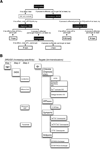Inverse drug screens: a rapid and inexpensive method for implicating molecular targets
- PMID: 17078061
- PMCID: PMC3142945
- DOI: 10.1002/dvg.20246
Inverse drug screens: a rapid and inexpensive method for implicating molecular targets
Abstract
Identification of gene products that function in some specific process of interest is a common goal in developmental biology. Although use of drug compounds to probe biological systems has a very long history in teratology and toxicology, systematic hierarchical drug screening has not been capitalized upon by the developmental biology community. This "chemical genetics" approach can greatly benefit the study of embryonic and regenerative systems, and we have formalized a strategy for using known pharmacological compounds to implicate specific molecular candidates in any chosen biological phenomenon. Taking advantage of a hierarchical structure that can be imposed on drug reagents in a number of fields such as ion transport, neurotransmitter function, metabolism, and cytoskeleton, any assay can be carried out as a binary search algorithm. This inverse drug screen methodology is much more efficient than exhaustive testing of large numbers of drugs, and reveals the identity of a manageable number of specific molecular candidates that can then be validated and targeted using more expensive and specific molecular reagents. Here, we describe the process of this loss-of-function screen and illustrate its use in uncovering novel bioelectrical and serotonergic mechanisms in embryonic patterning. This technique is an inexpensive and rapid complement to existing molecular screening strategies. Moreover, it is applicable to maternal proteins, and model species in which traditional genetic screens are not feasible, significantly extending the opportunities to identify key endogenous players in biological processes.
Figures



References
-
- Adam A, Bartfai R, Lele Z, Krone PH, Orban L. Heat-inducible expression of a reporter gene detected by transient assay in zebrafish. Exp Cell Res. 2000;256:282–290. - PubMed
-
- Adams D, Levin M. Gap junctions and ion fluxes in patterning: Strategies for investigating biophysical epigenetic control mechanisms in Xenopus. In: Whitman M, Sater AK, editors. Analysis of Growth Factor Signaling in Embryos. Washington, DC: Taylor and Francis Books; 2005.
-
- Alshuaib WB, Mathew MV. Blocking effect of lanthanum on delayed-rectifier K+ current in Drosophila neurons. Int J Neurosci. 2004;114:639–650. - PubMed
Publication types
MeSH terms
Substances
Grants and funding
LinkOut - more resources
Full Text Sources
Medical

